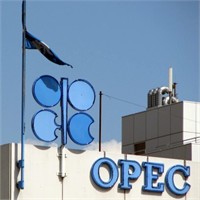
OPEC Headquarters
LONDON (Dow Jones), Jan. 19, 2010
Oil prices remain vulnerable to seasonal demand weakness and high oil inventories, OPEC said Tuesday, reinforcing expectations that the group will keep output steady when it meets in March.
The Organization of Petroleum Exporting Countries kept its global oil demand forecast unchanged for 2010, however, in contrast with a recent downward revision by the International Energy Agency.
Oil prices traded below $78 a barrel Tuesday but remained comfortably at the top end of OPEC members' preferred $70-$80 range. Although a cold snap across much of the Northern Hemisphere has helped firm up demand and boost prices, OPEC remains concerned about downward pressure on oil prices as the heating season nears its end.
"The persisting stock overhang, low seasonal demand and start of refining maintenance point to the need for continued caution over the coming months as market volatility is expected to remain," OPEC said in its January report.
The report follows statements in recent days by oil ministers from OPEC members Qatar and Libya that they saw no need to change output at current prices. OPEC is next due to meet in Vienna on March 17.
An unexpected global cold snap couldn't fully explain the recent oil-price rally, which also was driven by investment inflow into commodities markets, OPEC said.
"Prices are likely to be particularly vulnerable to economic developments during the upcoming low-demand second quarter," OPEC said in the report.
U.S. West Texas Intermediate oil prices averaged $82.5 a barrel early January, "the highest starting point in recent years" with the exception of 2008, OPEC said.
"Should developments turn out to be less positive than expected, market attention will revert back to weak oil fundamentals," which include high oil inventories, OPEC said.
The oil-producers' group is particularly concerned by high inventory levels in industrialized nations. It said commercial stocks in rich nations were stable at 58.9 days' worth of demand in November compared to the previous month.
OPEC worries the high stock levels could weigh on oil prices even as demand for OPEC crude is still expected to fall this year. The group doesn't want to lose market share to non-OPEC producers, who are expected to increase their oil output.
OPEC now sees non-OPEC oil supply increasing by 0.35 million barrels a day this year to average 51.31 million barrels a day, an upwards revision of 42,000 barrels a day. The non-OPEC growth is driven by higher production in Brazil, the U.S. and Azerbaijan.
By contrast, demand for OPEC crude is expected to average 28.6 million barrels a day this year, a decline of 0.1 million barrels a day from 2009.
OPEC, however, kept its world oil demand forecast for 2010 nearly unchanged from last month's estimate. Global demand is expected to grow by 0.8 million barrels a day in 2010 to average 85.1 million barrels a day.
Friday, the IEA revised slightly downward its 2010 forecast for world oil demand growth. But the agency, which acts as an energy adviser and forecaster to mostly wealthy nations, still has a more optimistic estimate than OPEC. It sees oil consumption growing globally this year by 1.44 million barrels a day.
Based on secondary sources cited in the OPEC report, compliance to agreed production cuts fell to 56% in December, down from 58% in November.